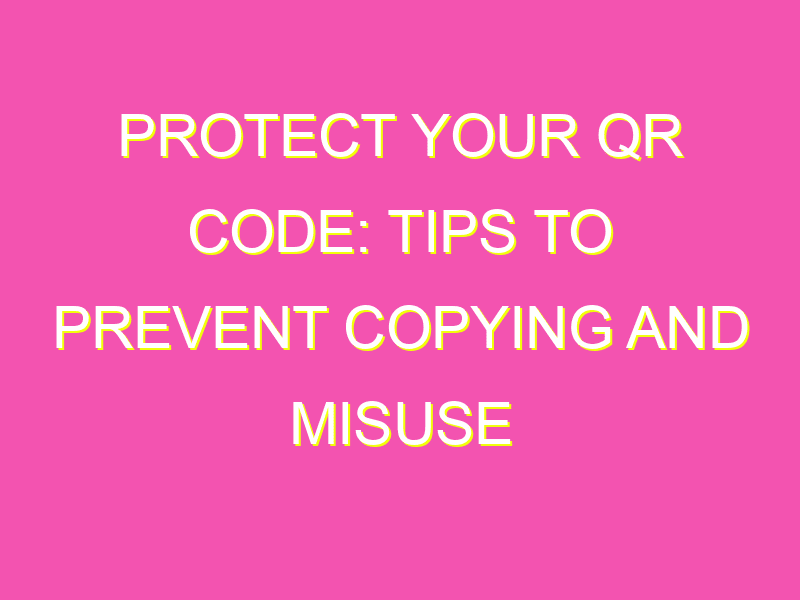Protecting QR codes is crucial, especially when it comes to thwarting counterfeiters and ensuring the authenticity of products. Fraudsters can easily replicate the packaging of a product and its Secure QR codes, leading unsuspecting consumers down a path of deception. So how can you secure your QR codes and prevent counterfeiting? Check out these three ways:
In conclusion, securing QR codes is essential for preventing counterfeiting and ensuring that consumers can trust the products they’re buying. By using Secure QR codes and these additional measures, you can ensure greater protection for your products, packaging and consumers alike.
Introducing Secure QR Codes for Anti-Counterfeiting Purposes
QR codes are undoubtedly one of the most versatile marketing tools available in the digital era. They provide a quick and easy way to access product information, websites, and other multimedia content. However, with their increasing popularity, QR codes have become a prime target for counterfeiters looking to replicate packaging and pass off fake products as the genuine article. To combat this threat, the use of Secure QR codes has become an effective anti-counterfeiting method employed by manufacturers across a range of industries such as cosmetics, pharmaceuticals, and automotive products.
Understanding the Threat of Counterfeiters to Packaging
Counterfeiters are becoming more sophisticated and are able to replicate packaging, including the Secure QR codes, with alarming accuracy. Customers who unknowingly purchase counterfeit products are at risk of purchasing products that do not meet safety standards, have subpar performance or whose ingredients may be harmful. Moreover, the damage to the brand reputation and the potential litigation can be devastating.
Security Images and their Importance in QR code Protection
One effective way of protecting a QR code from being copied is by embedding it with security images that are resistant to duplication. The use of such images in Secure QR codes enables scanning devices to differentiate between genuine and fake ones. The security images can be custom-designed and added either directly to the QR code or within the surrounding graphics or provided as a separate image. Using images with micro-sized structures created by a combination of photolithography and laser processes, companies can add secure codes to their products that are difficult to replicate. Such a security measure helps prevent the creation of fraudulent copies, ensuring that customers have access to genuine products.
Embedding images in the QR code: One simple way to protect a QR code is to embed it with a logo or trademark image that is difficult to duplicate.
Micro-images: Micro-images are used to embed an image in a QR code that is too small to reproduce. These images are essentially tiny repetitions of a company’s logo or product name, making them impossible to duplicate.
How to Design Secure QR Codes with Embedded Security Features
To design a Secure QR code, manufacturers must follow the following best practices:
Set unique encryption keys: Use a unique encryption key to encrypt the code, which makes it difficult for counterfeiters to replicate.
Create multiple unique codes: Use multiple unique codes for Secure QR codes, making it difficult to guess the code to access the information.
Create a customized design: Create a unique design, such as adding graphics, logos or other security features embedded in the QR code.
The Risks of Fake QR Codes and Their Impact on Consumers
The use of fake QR codes is a major threat to consumers, as it puts them at risk of purchasing counterfeit products. These products can be fake, unsafe, and harmful to the consumer’s health. Moreover, counterfeiters may use fake QR codes to deliver malware, ransomware, or other malicious software to a consumer’s device. In case of these scenarios, the customers lose their trust in the brand and can lead to a drop in sales resulting from the damage done.
Best Practices for Implementing Secure QR Codes on Packaging
To prevent the use of fake QR codes by counterfeiters, manufacturers must implement best practices, which includes:
Implementing authentication protocols: Use multi-factor authentication protocols to ensure that only authorized personnel have access to the codes.
Using tamper-evident packaging: Use tamper-evident packaging to ensure that the product has not been tampered with or replaced with a counterfeit.
Implementing a data-capture and tracking system: Implement a tracking system that can capture the data generated by each code scan. This can help identify counterfeit products, detect patterns, and ensure the highest level of quality assurance for products.
The Future of Anti-Counterfeiting Technology with Secure QR Codes
In conclusion, the use of Secure QR codes, with embedded security features, has become a reliable anti-counterfeiting technology. However, there is still room for growth and improvement because counterfeiters will continue to find ways to replicate and hack Secure QR codes. Manufacturers need to keep up by exploring new technologies that may incorporate artificial intelligence, blockchain, NFC near-field communication, or other security measures to ensure the integrity of their products will remain the same. Nevertheless, the use of Secure QR codes will stand as the front line in protecting companies from counterfeiters in the years to come.





